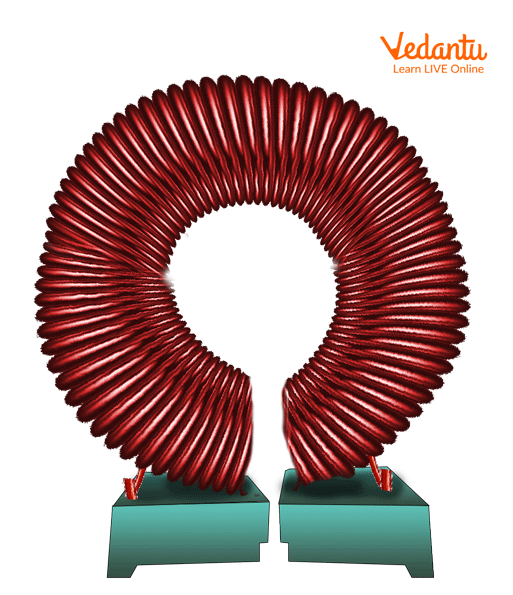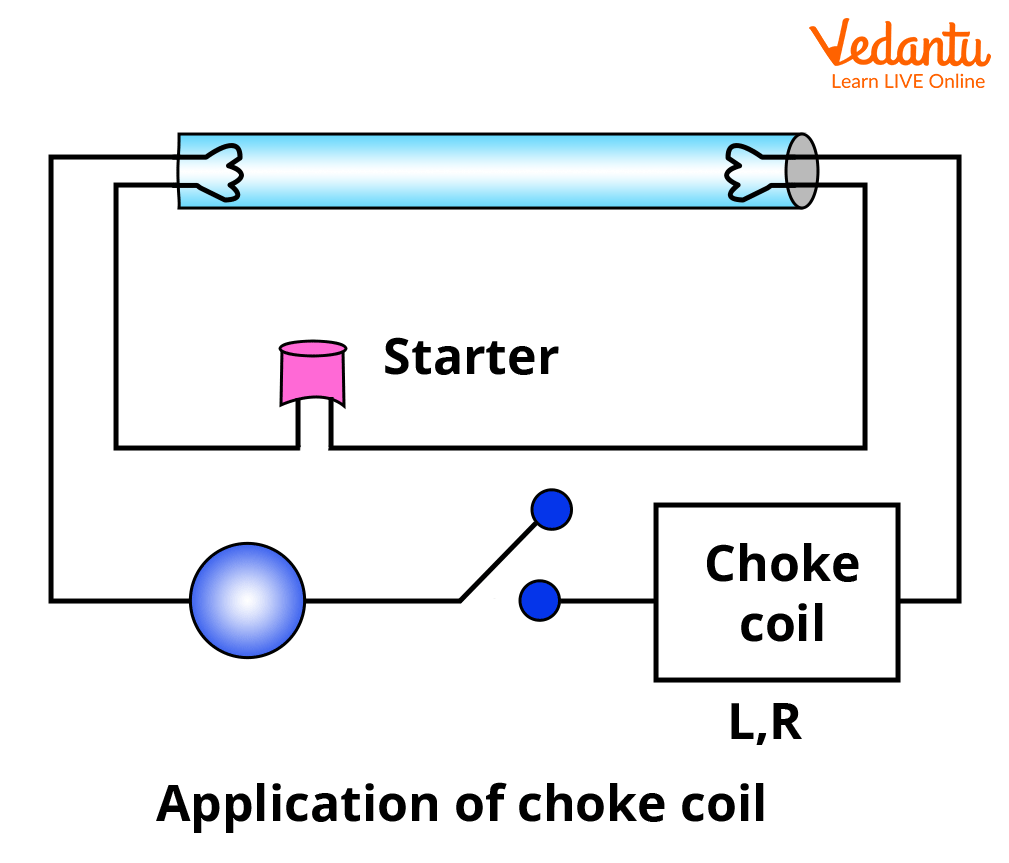




How Does a Choke Coil Work and Where Is It Used?
A choke coil is a vital component in alternating current (AC) circuits, designed to oppose the flow of AC while permitting direct current (DC) with minimal resistance. Its operation relies on the principle of self-inductance and it is commonly utilized in devices like tubelights and electronic filters due to its efficiency and minimal energy loss compared to resistors.
Choke Coil: Definition and Principle of Operation
A choke coil, also known simply as a ‘choke,’ is an inductor made by winding insulated wire on a magnetic core, often iron or ferrite. Its primary function is to limit or block alternating current (AC), but allow direct current (DC) to pass through almost unimpeded. This behavior arises from its inductive reactance, which is frequency-dependent.
The working principle is based on self-inductance. Whenever AC flows through the coil, a self-induced electromotive force (emf) opposes the change in current, in accordance with Faraday’s law of electromagnetic induction. The inductive reactance offered is given by $X_L = \omega L = 2\pi f L$, where $f$ is the frequency and $L$ is the coil’s inductance.
Construction and Diagram of a Choke Coil
A standard choke coil consists of multiple turns of enamelled copper wire wound tightly around a cylindrical core, typically made from laminated iron to enhance inductance while minimizing losses. The quality of the core determines the level of reactance and efficiency in AC circuits.

In electrical circuit diagrams, a choke coil is usually represented by the inductance symbol, consisting of a series of curved lines or loops. In practical circuits, these coils are installed in series to suppress or block unwanted AC components.
Function of a Choke Coil in AC and DC Circuits
In an alternating current (AC) circuit, a choke coil offers significant opposition to current due to its high inductive reactance. For direct current (DC), since the frequency is zero, the reactance is also zero, and the coil behaves like a simple conductor with negligible resistance.
This selective blocking property enables choke coils to filter out AC ripples and protect sensitive devices by restricting sudden current changes. For further explanations on alternating current, refer to Electromagnetic Induction and AC.
Choke Coil in Tubelights and Electronic Applications
In fluorescent tubelights, the choke coil serves two major purposes. During ignition, it generates a high voltage ‘kick’ by rapidly interrupting the current, enabling the breakdown of inert gases inside the tube. Once the light is operational, the choke acts as a ballast, maintaining the current at safe levels.

Choke coils are also used in power supplies to suppress high-frequency noise as low-pass filters, and in radio frequency circuits to block undesired signal components. Filtering applications exploit the increase in reactance with signal frequency.
Mathematical Representation: Inductive Reactance of a Choke Coil
The opposition provided by a choke coil to AC is termed as inductive reactance. It is calculated as:
$X_L = 2\pi f L$
where $X_L$ is the inductive reactance (ohms), $f$ is the frequency (hertz), and $L$ is the inductance (henry). As frequency increases, the choke coil blocks a greater portion of the AC component, making it effective for filtering and protection tasks.
Comparison: Choke Coil, Inductor, and Resistor
While all choke coils are inductors, their role and construction are optimized to maximize AC opposition without significant energy loss, unlike general resistors. Understanding these distinctions is important for correct circuit design.
| Parameter | Choke Coil |
|---|---|
| AC Opposition Mechanism | Inductive Reactance |
| Power Loss | Minimal (due to low resistance) |
| Core Material | Iron/Ferrite for higher inductance |
| Typical Application | Filtering, Ballast in Tubelights |
Applications of Choke Coils
Choke coils are employed in various AC circuits where selective filtering or current limiting is required. Their efficiency is particularly valuable in reducing energy loss and protecting devices.
- Used as current-limiting ballast in tubelights
- Filters out high-frequency noise in power supplies
- Suppresses AC ripples in rectifier circuits
- Protects sensitive devices from voltage surges
- Implements low-pass filtering in audio and radio
Solved Example: Choke Coil in an AC Circuit
Calculate the inductive reactance and current for a choke coil of inductance $0.5\, \text{H}$ connected to a $50\,\text{Hz}$, $220\,\text{V}_{\mathrm{rms}}$ AC supply:
$X_L = 2\pi f L = 2 \times 3.14 \times 50 \times 0.5 = 157\,\Omega$
Current, $I = \dfrac{V}{X_L} = \dfrac{220}{157} \approx 1.4\,\text{A}$
This example highlights that the choke coil limits current primarily through inductive reactance, not through energy dissipation as in a resistor. For further details, see Inductive Reactance and Capacitive Reactance.
Common Misconceptions Regarding Choke Coils
Choke coils do not block DC after the initial transient; their main effect is on AC signals, providing high opposition only to time-varying currents. Power loss in an ideal choke coil is minimal, unlike in resistors, and their inductance is usually fixed for stable performance in circuits.
Types of Choke Coils Used in Circuits
Choke coils are classified by their core material and frequency application. Iron-core chokes are used for low-frequency, high-current circuits, such as lighting ballasts. Air-core chokes are suitable for high-frequency filtering in radio and communication equipment.
For understanding related electromagnetic concepts, consult Self Inductance in Circuits.
Advantages and Limitations of Using Choke Coils
A choke coil allows for efficient current control in AC circuits, as it restricts current without producing significant heat. Its main limitation is that it cannot block DC and may be bulky for some applications, depending on required inductance and current rating.
- Energy efficient for AC current regulation
- Reduces heat-related power loss versus resistors
- Improves circuit safety and stability
- Cannot replace capacitors for DC blocking
Summary Points on Choke Coils for Competitive Exams
A choke coil is a specialized inductor designed to limit or block AC while permitting DC. It operates on the basis of self-inductance, is essential in AC filtering, and is favored for its low power loss and high efficiency.
For further study of AC circuit components and their behavior, refer to RC Circuit Explained and Understanding Transformers.
In advanced study, the interaction of choke coils with electromagnetic induction and alternating currents is also significant. Consider reviewing Dual Nature of Matter and Radiation for applications in modern physics.
FAQs on What Is a Choke Coil? Working Principle and Applications
1. What is a choke coil?
A choke coil is an electrical component designed to limit or regulate the flow of alternating current (AC) in a circuit while allowing direct current (DC) to pass through with minimal resistance.
• It consists of a coil of insulated wire wound around a magnetic core.
• Choke coils are primarily used to block high-frequency AC signals while permitting lower frequency or DC components.
• Common applications include fluorescent lamps, radio circuits, and power supplies.
This component is vital for managing current and protecting other devices in electrical circuits.
2. What is the function of a choke coil in an AC circuit?
The function of a choke coil in an AC circuit is to reduce or control the amount of alternating current (AC) passing through without significant energy loss.
Key points:
- It provides high inductive reactance to AC, effectively 'choking' or limiting it.
- It offers very low resistance to direct current (DC), causing minimal voltage drop for DC.
- Choke coils help filter out AC ripples in power supplies and protect sensitive equipment from current surges.
3. How does a choke coil differ from a resistor?
A choke coil differs from a resistor mainly in how it limits AC and handles energy loss.
• Choke coil: Blocks AC due to its inductive reactance but allows DC with little resistance; does not dissipate much heat.
• Resistor: Limits both AC and DC by converting electrical energy into heat, causing power loss.
Thus, choke coils are energy-efficient for controlling AC, while resistors work equally for both AC and DC but waste energy as heat.
4. Why is an iron core used in a choke coil?
An iron core is used in a choke coil to increase its inductance and effectiveness.
The benefits of an iron core include:
- Amplifies the magnetic field, raising the coil's inductance for the same number of turns.
- Allows for a compact design with high reactance.
- Improves the coil's ability to block AC efficiently while permitting DC flow.
5. What are the applications of a choke coil?
Choke coils are widely used in electrical and electronic circuits for various purposes. Some common applications include:
- Fluorescent tube lights – to limit current in the circuit.
- Radio and TV circuits – as filters to block certain frequencies.
- Power supplies – to smooth out AC ripples (as filter chokes).
6. Can a choke coil be used in DC circuits?
A choke coil is ineffective in DC circuits because it offers very low resistance to DC after the initial moment the circuit is switched on.
- Initially, a choke coil briefly opposes changes in current (due to inductance).
- Once the current stabilises, the coil behaves almost like a simple wire with negligible resistance.
7. What is the principle behind the working of a choke coil?
The principle of a choke coil is based on the property of inductance.
- When AC passes through the coil, it creates a changing magnetic field that induces an opposing emf (according to Lenz's Law).
- This opposing emf restricts the flow of AC, hence 'choking' it.
- The coil's inductive reactance varies with the frequency of the current; higher frequencies are opposed more effectively.
8. How does a choke coil reduce energy loss compared to a resistor?
A choke coil reduces energy loss because it opposes AC using inductive reactance rather than actual resistance.
- The coil stores energy in its magnetic field temporarily and returns it to the circuit, rather than dissipating it as heat.
- This process leads to much lower power loss compared to a resistor, making chokes ideal for efficient current regulation.
9. Why is a choke coil preferred over a resistance for limiting current in an AC circuit?
A choke coil is preferred over a resistance in AC circuits because it limits current without significant energy loss.
- Choke coils block AC using inductive reactance, not resistance.
- This approach avoids wasting electrical energy as heat, unlike resistors.
- Therefore, choke coils are more energy-efficient and better protect circuit components.
10. Explain the construction of a choke coil.
The construction of a choke coil is simple yet effective. It generally consists of:
- A coil of insulated copper wire.
- The wire is wound around an iron core (or sometimes an air core).
- The iron core increases the coil's inductance, making it more effective in opposing AC.
























